November 5, 1919 - July 23, 2005
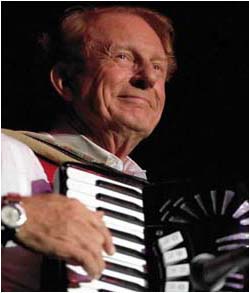
THE
ACCORDIONIST WHO PLAYED IN 32.5 MILLION HOMES
by
Faithe Deffner
| His boyish grin, his easy style, his personal warmth and meticulous musicianship all combined to make Myron Floren a legendary accordionist among the greats of the 20th century. Floren, who starred on the Lawrence Welk Show for more than 50 years, died of cancer July 23, 2005 at his home in Rolling Hills, California, at the age of 85. | ||
| A
consummate musician, Myron could play everything from a polka to a pop song to
a Bach cantata with equal style, grace and virtuosity. Through the Welk TV Show, Myron brought the accordion into 32.5 million homes. Multi-generational viewers enjoyed his accordion music when the Champagne Music Orchestra came into their homes and paid homage to wholesome family life every Saturday night for 40 years. It is awesome to realize that accordionist Myron Floren starred on the longest-running show in TV history. | |
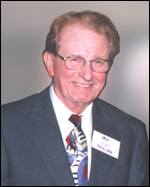 Floren
was Welk's right-hand man and one of the most popular members of his musical "family,"
which included regulars such as singer-pianist Larry Hooper, singer Joe Feeney,
honky-tonk pianist Jo Ann Castle, dancers Bobby Burgess and Barbara Boyland, the
Lenon Sisters and Champagne Lady Norma Zimmer.
Floren
was Welk's right-hand man and one of the most popular members of his musical "family,"
which included regulars such as singer-pianist Larry Hooper, singer Joe Feeney,
honky-tonk pianist Jo Ann Castle, dancers Bobby Burgess and Barbara Boyland, the
Lenon Sisters and Champagne Lady Norma Zimmer.In some biographical writings, Myron Floren says, "I was born and raised on a small farm near Roslyn, South Dakota. Television hadn't even been discovered, and the main entertainment in those days consisted of neighbors who got together on Saturday night to visit, tell tall stories, roll back the rugs, and do a bit of old-time waltzing or square dancing and naturally quite a few polkas.
"When I discovered the accordion, I was only about four years old. I recall, as if it were yesterday, how I got interested in the accordion. Quite often, my family visited the Gilbert Lensegrav family, some of our in-laws. They lived on a farm about two miles south of Roslyn. There was always music on those occasions as my Dad played the fiddle and others would come to join in the fun and enjoy the social dancing. One night, a farmer by the name of Johnny Bjugan was present; he played an accordion, a semi-tone Hohner often referred to as a "button box" today. That evening, I sat on the floor totally captivated, watching and listening to the accordion music. For some reason, I was hooked on the accordion from that day forward, though I was not yet old enough, at age four, to communicate my inner yearning to learn the accordion.
"Just two years later, however, after much pleading with my Dad, he finally bought me a beautiful new 'button box'." When he was eight, Myron was invited to play his accordion at the Day County Fair in Webster, South Dakota. That was his first paid engagement. He received $10 for two shows a day for two days.
In his youth, Myron listened to the Major Bowes Family Hour on Sunday mornings over NBC radio and to Bowes' amateur hour Thursday nights on ABC radio. "One thing I noticed was that accordionists almost always won the competition, and this seemed to further reinforce my love and admiration for the accordion. Since Charles Magnante was featured regularly on Major Bowes Family Hour, this was one show that I never missed."
"I was teaching about 75 students at that time, but looking back, I honestly don't know where I found the time to do the teaching because I had four radio shows a day, jobs at night with 'Bill and His Old-Timers' and was taking classes at Augustana College," in Sioux Falls, South Dakota. Berdyne Koerner, later to become Mrs. Myron Floren, was one of many students at the Floren Accordion Studios at that time.
Myron's interest in flying led him to enlist in the newly created Army Air Corps, but he was turned down because a childhood bout with rheumatic fever had damaged his heart valve. "So, instead, I volunteered for USO camp shows, traveling to the European Theatre of war," Myron related. "When I arrived in Europe, I slept on Omaha Beach my first day on the Continent, listening to shell fire only a few miles away. Then, the next day I met Jerry Shelton, whose accordion artistry I had heard with the Shep Fields Orchestra. During the next 14 months," Myron continues, "we played shows sometimes only a half-mile from the active front lines. We really wowed the troops. The G.I. audience was simply the greatest! They truly appreciated our acts and style of entertainment."
When WWII ended in Europe, Myron came home. He married Berdyne August 19, 1945. Sadly, he died less than a month before their 60th anniversary in 2005.
In 1946, Floren began to play with a group called the "Buckeye Four" in St. Louis. He was doing five network shows a week, in addition to teaching and other appearances. In March 1950, the Florens were celebrating Berdyne's birthday at the Casa Loma Ballroom in St. Louis where the Welk orchestra was appearing. Lawrence recognized Myron in the audience and invited him to come up on stage to play the accordion. Myron related the incident in his usual modest fashion, "I had a lot of friends there, and I got a big hand. Lawrence came over to our table during the intermission and offered me a job with the band.
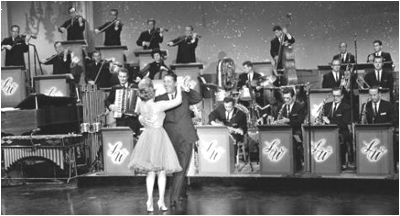 "Lawrence
was doing one-niters all over the country and a radio show on Friday nights over
ABC. This opportunity led to shows in New York and Los Angeles and many points
in between. In the fall of 1950, we did a show on the Dumont TV Network in New
York. Shows were still in black and white. From there, we went to Los Angeles,
doing shows on KTLA. Our audience at the Aragon Ballroom in Santa Monica grew
from 300 to 3,000 in just four weeks. Our future seemed rosy, indeed. I was earning
$20 a night from Lawrence Welk."
"Lawrence
was doing one-niters all over the country and a radio show on Friday nights over
ABC. This opportunity led to shows in New York and Los Angeles and many points
in between. In the fall of 1950, we did a show on the Dumont TV Network in New
York. Shows were still in black and white. From there, we went to Los Angeles,
doing shows on KTLA. Our audience at the Aragon Ballroom in Santa Monica grew
from 300 to 3,000 in just four weeks. Our future seemed rosy, indeed. I was earning
$20 a night from Lawrence Welk."When in 1955, the Dodge Motor Company searched for a summer replacement for one of their TV shows, the Champagne Music Makers were among the three groups under consideration. Welk was chosen and his orchestra appeared in the Dodge spotlight on ABC-TV for the next 12 years. After that, Welk's advisors offered the show to some 600 TV stations in syndication, which was a new concept at the time. To their delight, more than 400 stations clamored for the show. In the fall of 1967, the Champagne Music Makers smoothly transitioned from ABC to syndication. The original 180 ABC stations turned into a total of 275 TV stations, comprised of 100 ABC affiliates and the rest from CBS and NBC, exposing the show to even greater audiences.
"Ratings were higher than ever," Floren continues. "For 31 years, we appeared weekly on network television. My friends often said jokingly that I had the best known accordion on television and the flashiest ring - a present from Berdyne on our 25th wedding anniversary."
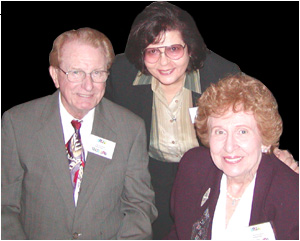 In
a 1995 statement, Myron noted, "Over the years the Welk Show featured Charles
Magnante, Art Van Damme, Bill Palmer, Bill Hughes, Frank Marocco, Johnny LaPadula,
Frank Yankovic and many others. Whether you appreciated their various styles or
not doesn't really matter. The show kept the accordion in front of the public.
The show also popularized the beautiful instrument loved by accordion aficionados
everywhere, and it paved the way for so many talented young artists who are well
known today - perhaps even famous - because of opportunities afforded through
the efforts of Lawrence Welk." (Myron and his wife are pictured here with
long time friend and author, Faithe Deffner.)
In
a 1995 statement, Myron noted, "Over the years the Welk Show featured Charles
Magnante, Art Van Damme, Bill Palmer, Bill Hughes, Frank Marocco, Johnny LaPadula,
Frank Yankovic and many others. Whether you appreciated their various styles or
not doesn't really matter. The show kept the accordion in front of the public.
The show also popularized the beautiful instrument loved by accordion aficionados
everywhere, and it paved the way for so many talented young artists who are well
known today - perhaps even famous - because of opportunities afforded through
the efforts of Lawrence Welk." (Myron and his wife are pictured here with
long time friend and author, Faithe Deffner.)After 32 years on the various networks, the Welk Show took on yet another dimension in 1981 when it became a regular weekly attraction on Public Broadcasting Stations. Myron continues to be seen in reruns of the Welk Show regularly slotted on weekly PBS, still bringing his happy accordion music into millions of homes.
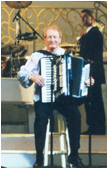 Until
very recently, the "Happy Norwegian," as Myron was fondly nicknamed,
traveled as much as 150,000 miles annually playing some 150 special engagements
and appearing with other Welk performers at the Welk Resort in Branson, Missouri
and other venues. Myron loved the grueling schedule. "Making people happy
keeps me young," he often said, as he played his accordion with unparalleled
ease. He loved every moment of creating those toe-tapping melodies to delight
his fans. Myron's concert appearances earned him a solid reputation as one of
the country's most sought-after entertainers.
Until
very recently, the "Happy Norwegian," as Myron was fondly nicknamed,
traveled as much as 150,000 miles annually playing some 150 special engagements
and appearing with other Welk performers at the Welk Resort in Branson, Missouri
and other venues. Myron loved the grueling schedule. "Making people happy
keeps me young," he often said, as he played his accordion with unparalleled
ease. He loved every moment of creating those toe-tapping melodies to delight
his fans. Myron's concert appearances earned him a solid reputation as one of
the country's most sought-after entertainers.The respect of one's peers is the greatest measure of a person's achievement and Myron was indeed esteemed by his colleagues. Thus in 1992, the Confederation Internationale des Accordionistes (CIA) bestowed their Merit Award on Floren, at its Congress in Trossingen, Germany, in recognition of his outstanding contribution to the international accordion movement. In 1996, the American Accordionists' Association honored Floren as the widely acclaimed star of the ongoing Lawrence Welk TV Show. He conducted the festival's massed band of hundreds of accordionists at Independence Park in downtown Philadelphia, appeared at the Myron Floren Tribute Concert with the Tim Laushey Orchestra and was feted at an AAA Testimonial Banquet. In 2004, the Accordionists and Teachers Guild inducted Myron into the ATG International Accordion Hall of Fame, citing the extraordinary prominence he brought to the accordion world in a legendary career as an entertainer.
| The
New York Times reported in a 1997 interview with Floren that he reminisced about
the Welk Orchestra playing for a crowd of 21,000 people at Madison Square Garden
in the 70s. "You could feel the electricity in the air," he recalled.
"Lawrence and I were looking out at the crowd and he leans over to me and
says, 'Isn't it wonderful what can happen in this country to a couple of farmers
from the Dakotas?'" Myron is survived
by his wife, Berdyne, five daughters and three sons-in-law: Kristie and Bobby
Burgess (one of the stars of the Welk Show); Robin and Tom Cipolla; Heidi Floren
and husband Sam Gennawey, Holly and Randee. |
USO World Headquarters
Attn: Margo Durham
2111 Wilson Blvd., Suite 1200
Arlington, VA 22201